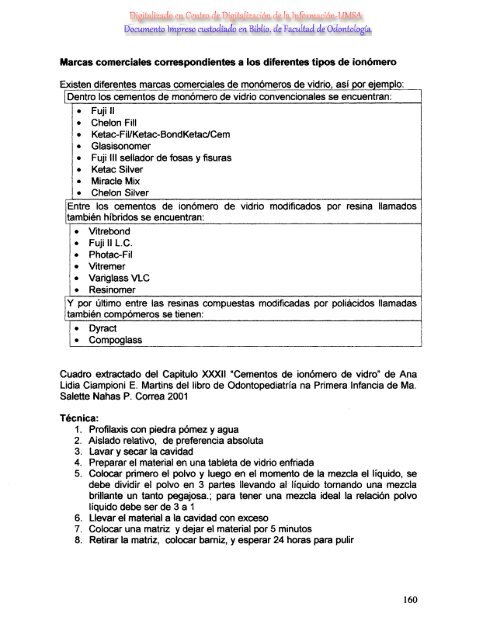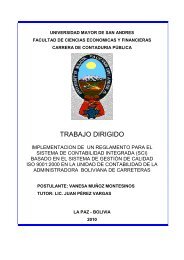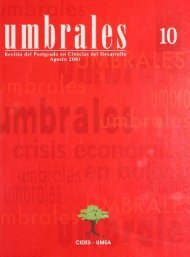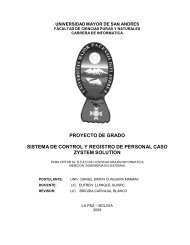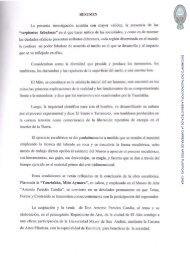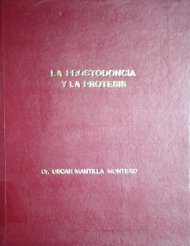- Page 1 and 2:
!1 E 1 '4 r^ [ •
- Page 4 and 5:
TÍTULO DEL LIBRO: CLÍNICA DE ODON
- Page 6 and 7:
AGRADECIMIENTOS -Un agradecimiento
- Page 8 and 9:
PRESENTACiÓN El propósito de esta
- Page 10 and 11:
CUARTA UNIDAD OTRAS ALTERNATIVAS DE
- Page 12 and 13:
acabar con la Odontología. Hoy se
- Page 14 and 15:
De acuerdo a la información de la
- Page 16 and 17:
• Participación Interinstitucion
- Page 18 and 19:
También es recomendable mencionar
- Page 20 and 21:
Comunicación constante y sincera /
- Page 22 and 23:
REFERENCIAS BIBLIOGRÁFICAS ARTEAGA
- Page 24 and 25:
De este primer contacto, dependerá
- Page 26:
• Historia Presente de la Enferme
- Page 29:
c) Exploración intrabucal Se debe
- Page 32 and 33:
Radiografía digital Imagen de diag
- Page 34 and 35:
• Laboratorio: Análisis de sangr
- Page 36 and 37:
DESARROLLO DEL PLAN DE TRATAMIENTO
- Page 38 and 39:
HISTORIA CLíNICA Autorización de
- Page 40 and 41:
Tuvo alguna molestia? . Uso chupón
- Page 42 and 43:
Le aplicaron flúor por buchadas? C
- Page 44 and 45:
h) Elementos auxiliares de Diagnós
- Page 46 and 47:
SÉlLER, S. E.&MANSON; HINHING, L..
- Page 48 and 49:
Niño con alto riesgo de caries De
- Page 51 and 52:
NIVELES DE PREVENCiÓN Será más e
- Page 53 and 54:
Esta información debe contener lo
- Page 55 and 56:
Uno de los sentidos que más estimu
- Page 57 and 58:
la concentración de flúor en el a
- Page 59 and 60:
solo un minuto, disminuyendo de est
- Page 61 and 62:
Cuando los niños son demasiado peq
- Page 63 and 64:
Se comercializa en la actualidad en
- Page 65 and 66:
3. Piezas recién erupcionadas. Por
- Page 67 and 68:
Nutrición, se refiere a los efecto
- Page 69 and 70:
quiera, pero sin olvidar por ningú
- Page 71 and 72:
con movimientos circulares de ampli
- Page 73 and 74:
• Aglutinantes Sirven para estabi
- Page 75 and 76:
El hilo debe ser colocado paralelo
- Page 77 and 78:
4. Recursos Son elementos utilizado
- Page 79 and 80:
VILLENA R; CURY JAIME Flúor -Aplic
- Page 81:
sensación se presenta en los niño
- Page 84 and 85:
Modelado Puede ser directo, cuando
- Page 86 and 87:
En esta visita se infonnará tanto
- Page 88 and 89:
airways (mano sobre boca y vías a
- Page 90 and 91:
NIÑOS DE DIFERENTES EDADES
- Page 92 and 93:
demostrar rabietas, se complace con
- Page 94 and 95:
CAPÍTULO V EL NIÑO MENOR DE 3 AÑ
- Page 96 and 97:
presenta la edad de las preguntas:
- Page 98 and 99:
hace el control de la prenatal, cue
- Page 100:
Cepillo digital Cuando erupcionan l
- Page 103 and 104:
que se deben evitar los riesgos de
- Page 105 and 106:
Cuando se sustituye la lactancia ma
- Page 107 and 108:
sensación dolorosa, especialmente
- Page 110 and 111:
Para una mejor comprensión se divi
- Page 112 and 113:
atención, el movimiento de los bra
- Page 114 and 115:
• Examen Clínico Se deberá obse
- Page 116 and 117:
REFERENCIA BIBLIOGRAFíA CARREA,M.S
- Page 118 and 119:
CAPÍTULO VI , , PRESCRIPCION EN LA
- Page 120 and 121:
2) RpI Receta Prescrita 3) Nombre-
- Page 122 and 123:
prostaglandina y los tromboxanos, c
- Page 124 and 125: ANTIBlóncos Aunque la palabra ant
- Page 126 and 127: La dosis para niños recomendada es
- Page 128 and 129: día para prematuros, ladantes meno
- Page 130 and 131: http/lwww.encolombia.comlvademecuml
- Page 132 and 133: tratamiento preventivo o realizar u
- Page 134 and 135: la proyección de los cuernos pulpa
- Page 136 and 137: inculcando conocimientos que refuer
- Page 138 and 139: Caries de biberón: Denominada tamb
- Page 142 and 143: La forma como interactúan estos ma
- Page 144 and 145: no pueden trasladarse hasta un cons
- Page 146 and 147: Otra mesa para colocar el instrumen
- Page 148 and 149: ortofosfórico al 37% que sirven pa
- Page 150: REFERENCIAS BIBLIOGRAFICAS ANUSAVIC
- Page 153: Diagnóstico pulpar Para realizar u
- Page 156 and 157: de dolor espontáneo, esta indicado
- Page 158 and 159: 2. Reducido número de células y f
- Page 160 and 161: Otro de los inconvenientes del hidr
- Page 162: adiopaco por lo que posee un buen n
- Page 166 and 167: aplicación de cariostáticos en la
- Page 168 and 169: 2. Establecer la forma de la cavida
- Page 171 and 172: • Preparación de cavidad elimina
- Page 173: después de 2 años, se recomienda
- Page 177 and 178: un banco de dientes, guardándolos
- Page 179 and 180: CAPÍTULO X I I LA INTEGRACION DE L
- Page 181 and 182: Un fonoaudiólogo debe realizar: pr
- Page 183 and 184: Otra forma de percibir algún distu
- Page 185 and 186: )Respiración nasal y bucal Cuando
- Page 187 and 188: actúan todos los músculos buco-ma
- Page 189 and 190: CAPÍTULO XI ENFERMEDADES SISTÉMIC
- Page 191 and 192: clohrexidina para buchadas o topica
- Page 193 and 194: El Herpes Zoster, enfermedad altame
- Page 195 and 196: Se identifican como agentes etioló
- Page 197 and 198: se clasifica en aguda y croruca de
- Page 199 and 200: Para el tratamiento se recomienda t
- Page 201 and 202: , CAPITULO XII ENFERMEDAD PERIODONT
- Page 203 and 204: Tipos de enfermedad gingival en el
- Page 205 and 206: tiende a durar de una semana a 10 d
- Page 207 and 208: • Predisoonentes Son los vehícul
- Page 209 and 210: 6. Control y mantenimiento La educa
- Page 211 and 212: CAPÍTULO XIII , - ODONTOLOGIA EN N
- Page 213 and 214: d) Enfermedades crónicas La falta
- Page 215 and 216: TRASTORNOS RESPIRATORIOS Uno de los
- Page 217 and 218: Trastornos Neurológicos Entre los
- Page 219 and 220: 1) Técnicas de higiene bucal Instr
- Page 221 and 222: pena mencionar al Dr. Javier Blanco
- Page 223 and 224: Al desplazarse una pieza temporaria
- Page 225 and 226:
Anamnesis Es la elaboración del in
- Page 227 and 228:
• En un accidente que afecta cavi
- Page 229 and 230:
a) LESIONES DE TEJIDOS PERIODONTALE
- Page 231 and 232:
Si el accidente sucede antes de la
- Page 233 and 234:
Si la fractura afecta el tercio cer
- Page 235 and 236:
CAPÍTULO XV ANESTESIA GENERAL EN L
- Page 237 and 238:
Ambiente , equipos e instrumental a
- Page 239 and 240:
• Deficiencia hepática, por la d
- Page 241 and 242:
• Inducción Se la lleva a cabo d
- Page 243 and 244:
• Por último las exodoncias y pr
- Page 245 and 246:
CAPÍTULO XVI OTRAS ALTERNATIVAS DE
- Page 247 and 248:
Este científico tenía en su poder
- Page 249 and 250:
salival, miedo, ansiedad, evitar la
- Page 251:
Los Kallawayas se situaron en la pr


